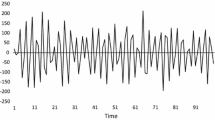Abstract
In response to the identification problem of nonlinear systems with harmonic input, this paper studies the identification effect of the different splicing way of the multi-harmonic input based model identification approach. In this method, the relationship between the input and output signals of the nonlinear system is represented by the Nonlinear Auto-Regressive model with exogenous inputs (NARX) model. Firstly, the modeling framework of the NARX model based on the multi-harmonic input method is introduced. Then the effect of the different splicing way contained sequence and period of splicing data on modeling results is researched and proved in theoretically. Finally, a case study is discussed to simultaneously validate that the different multi-harmonic signal splicing forms have no effect on the identification results.



Similar content being viewed by others
References
Nelles O (2013) Nonlinear system identification: from classical approaches to neural networks and fuzzy models. Springer, Berlin
Billings SA (1980) Identification of nonlinear systems–a survey. In: IEE Proceedings D (control theory and applications), IET, pp 272–285
Keesman KJ (2011) System identification: an introduction. Springer, Berlin
Liu H-P, Zhu Y-P, Luo Z, Han Q-K (2018) PRESS-based EFOR algorithm for the dynamic parametrical modeling of nonlinear MDOF systems. Front Mech Eng 13:390–400
Ma Y, Luo Z, Liu H-P, Zhu Y-P (2018) The NRSF-SVM based method for nonlinear rotor bearing fault diagnosis. In: Chinese Control And Decision Conference (CCDC), IEEE, pp 3978–3983
Qin Z-Y, Yan S-Z, Chu F-L (2011) Dynamic characteristics of launch vehicle and spacecraft connected by clamp band. J Sound Vib 330:2161–2173
Mu J, Rees D, Liu G (2005) Advanced controller design for aircraft gas turbine engines. Control Eng Pract 13:1001–1015
Zhang W, Li X, Jia X-D, Ma H, Luo Z, Li X (2020) Machinery fault diagnosis with imbalanced data using deep generative adversarial networks. Measurement 152:107377
Li X, Jia X-D, Zhang W, Ma H, Luo Z, Li X (2020) Intelligent cross-machine fault diagnosis approach with deep auto-encoder and domain adaptation. Neurocomputing 383:235–247
Li X, Zhang W, Xu N-X, Ding Q (2019) Deep learning-based machinery fault diagnostics with domain adaptation across sensors at different places. IEEE Trans Industr Electron 67:6785–6794
Elmarakbi A, Elkady M, MacIntyre J (2013) Numerical analysis of vehicle-to-vehicle impact using vehicle dynamics control systems for collision mitigation. Int J Dyn Control 1:172–191
Guo Y, Guo L, Billings SA, Wei H-L (2015) An iterative orthogonal forward regression algorithm. Int J Syst Sci 46:776–789
Billings SA, Wei H-L (2005) The wavelet-NARMAX representation: a hybrid model structure combining polynomial models with multiresolution wavelet decompositions. Int J Syst Sci 36:137–152
Zhu Y-P, Lang Z-Q (2017) Design of nonlinear systems in the frequency domain: an output frequency response function-based approach. IEEE Trans Control Syst Technol 26:1358–1371
Billings SA (2013) Nonlinear system identification: NARMAX methods in the time, frequency, and spatio-temporal domains. Wiley, New York
Ruano AE, Fleming PJ, Teixeira C, RodrıGuez-Vázquez K, Fonseca CM (2003) Nonlinear identification of aircraft gas-turbine dynamics. Neurocomputing 55:551–579
Ge SS, Zhang J, Lee TH (2004) Adaptive MNN control for a class of non-affine NARMAX systems with disturbances. Syst Control Lett 53:1–12
Mao K, Billings SA (1997) Algorithms for minimal model structure detection in nonlinear dynamic system identification. Int J Control 68:311–330
Farina M, Piroddi L (2012) Identification of polynomial input/output recursive models with simulation error minimisation methods. Int J Syst Sci 43:319–333
Araújo ÍB, Guimarães JP, Fontes AI, Linhares LL, Martins AM, Araújo FM (2019) NARX Model Identification Using Correntropy Criterion in the Presence of Non-Gaussian Noise. J Control Autom Electr Syst 30:453–464
Solares JA, Wei H-L (2015) Nonlinear model structure detection and parameter estimation using a novel bagging method based on distance correlation metric. Nonlinear Dyn 82:201–215
Billings SA, Wei H-L (2008) An adaptive orthogonal search algorithm for model subset selection and non-linear system identification. Int J Control 81:714–724
Chen S, Wang X, Harris CJ (2007) NARX-based nonlinear system identification using orthogonal least squares basis hunting. IEEE Trans Control Syst Technol 16:78–84
Billings SA, Chen S, Korenberg M (1989) Identification of MIMO non-linear systems using a forward-regression orthogonal estimator. Int J Control 49:2157–2189
Shariff HM, Marzaki MH, Tajjudin M, Rahiman MHF. (2013) System identification for steam distillation pilot plant: Comparison between linear and nonlinear models. In: IEEE 3rd International conference on system engineering and technology, IEEE, pp 263–268
Liu H, Song X (2015) Nonlinear system identification based on NARX network. In: 10th Asian Control Conference (ASCC), IEEE, pp 1–6
Wei H-L, Billings SA (2007) A comparative study on global wavelet and polynomial models for non-linear regime-switching systems. Int J Model Ident Control 2:273–282
Zhu Y-P, Lang Z-Q, Kawanishi Y, Kohiyama M (2020) Semi-actively Implemented Non-linear Damping for Building Isolation Under Seismic Loadings. Front Built Environ 6:19
Ge X-B, Luo Z, Ma Y, Liu H-P, Zhu Y-P (2019) A novel data-driven model based parameter estimation of nonlinear systems. J Sound Vib 453:188–200
Ma Y, Liu H-P, Zhu Y-P, Wang F, Luo Z (2017) The NARX model-based system identification on nonlinear, rotor-bearing systems. Appl Sci 7:911
Zhu Y-P, Lang Z-Q (2020) A new convergence analysis for the Volterra series representation of nonlinear systems. Automatica 111:108599
Acknowledgements
This project is supported by the National Natural Science Foundation of China (Grant Nos. 11872148, U1908217); the Fundamental Research Funds for the Central Universities of China (Grant Nos. N2003012, N2003013, N170308028, N180703018).
Author information
Authors and Affiliations
Corresponding author
Rights and permissions
About this article
Cite this article
Qiu, Y., Luo, Z., Ge, X. et al. Impact analysis of the multi-harmonic input splicing way based on the data-driven model. Int. J. Dynam. Control 8, 1181–1188 (2020). https://doi.org/10.1007/s40435-020-00700-4
Received:
Revised:
Accepted:
Published:
Issue Date:
DOI: https://doi.org/10.1007/s40435-020-00700-4




